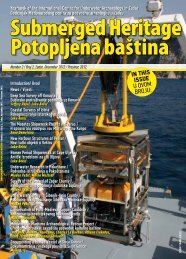Muzej u dubokom plavetnilu - Međunarodni centar za podvodnu ...
Muzej u dubokom plavetnilu - Međunarodni centar za podvodnu ...
Muzej u dubokom plavetnilu - Međunarodni centar za podvodnu ...
Create successful ePaper yourself
Turn your PDF publications into a flip-book with our unique Google optimized e-Paper software.
BIZZTIME<br />
MUZEJ U DUBOKOM PLAVETNILU | A MUSEUM IN THE DEEP BLUE<br />
<strong>Međunarodni</strong> <strong>centar</strong> <strong>za</strong> <strong>podvodnu</strong> arheologiju u Zadru, čiju je vrijednost prepoznao i UNESCO proglasivši ga ustanovom 2. kategorije / International Centre for Underwater<br />
Archaeology in Zadar was recognised by UNESCO that pronounced it a category 2 centre<br />
jedinstvenom slučaju gdje su se te rupičaste<br />
keramičke posude očuvale na originalnom<br />
mjestu (in situ). Nerijetko, nađu se i ostatci<br />
namjerno potopljenih brodova koji su na<br />
ulazima u luke neprijateljima priječili pristup<br />
s morske strane. Dva takva broda izvađena<br />
su iz mora 1974. godine pred Ninom, a kasnije<br />
je doka<strong>za</strong>no kako su brodovi iz 11. stoljeća<br />
te da su potopljeni tijekom obrane od<br />
napada Normana na hrvatsku obalu 1074.<br />
godine.<br />
<strong>Muzej</strong>i u kavezu<br />
Nažalost, turi<strong>za</strong>m te razvitak sportskoga<br />
ronjenja uz spužvarstvo i koraljarstvo prouzročili<br />
su nenadoknadive štete. Teret mnogobrojnih<br />
potopljenih brodova je <strong>za</strong>uvijek nestao<br />
ili je oštećen, a poznato je da su mnogi<br />
nalazi našli svoje mjesto u privatnim zbirkama.<br />
Amfore su postale simbol podmorske<br />
arheološke baštine, ali i njezine devastacije.<br />
Ipak hrvatski znanstvenici su tom haraču<br />
našli lijeka.<br />
Od 1990. godine važna arheološka nalazišta<br />
<strong>za</strong>štićena su kavezima, što je jedinstven<br />
način <strong>za</strong>štite u svijetu. Pristup je moguć jedino<br />
kroz poseban otvor. Takvih kavezom <strong>za</strong>of<br />
Stonac, parts of large ceramic pots were<br />
preserved. These pots could hold 1,000 litres<br />
and in ancient times they were used for<br />
storing agricultural and sea products. This<br />
is a unique case, because these perforated<br />
ceramic pots were preserved in their original<br />
location (in situ). Often, remains of deliberately<br />
sunk ships can be found. Such ships<br />
were used to prevent enemies, approaching<br />
from the sea, to enter ports. Two such ships<br />
were extracted from the sea in 1974 in front<br />
of Nin, and later on it was proved that the<br />
ships originated from the 11th century and<br />
that they were sunk during the Norman attack<br />
of the Croatian coastline in 1074.<br />
Museum In a Cage<br />
Unfortunately, tourism and the development<br />
of sport diving with sponge and coral diving<br />
have caused irrecoverable damages.<br />
The cargo of numerous sunken ships has<br />
gone forever or has been damaged and it is<br />
known that many ended up in private collections.<br />
Amphoras have become a symbol of<br />
undersea archaeological heritage, but also<br />
of its devastation. Still, Croatian scientists<br />
have found a solution for this plundering.<br />
<strong>Međunarodni</strong> <strong>centar</strong> <strong>za</strong> <strong>podvodnu</strong><br />
arheologiju tijekom rujna bit će domaćin<br />
eminentnoga skupa svjetskih znanstvenika<br />
koji se bave proučavanjem i <strong>za</strong>štitom<br />
arheološke i povijesne podvodne<br />
baštine. Taj skup bit će još jedan<br />
doprinos promociji podvodne arheologije<br />
i hrvatskoga ronilačkog turizma te<br />
hrvatskom načinu <strong>za</strong>štite podvodnih<br />
arheoloških nalazišta – in situ.<br />
During September, the International<br />
Centre for Underwater Archaeology<br />
will host an eminent meeting of world<br />
scientists who are engaged in research<br />
and the protection of archaeological<br />
and historical underwater heritage. This<br />
meeting will be one more contribution to<br />
the promotion of underwater archaeology,<br />
the Croatian diving tourism and the<br />
Croatian way of protecting underwater<br />
archaeological sites – in situ.<br />
onica <strong>za</strong> predavanja, uredi i drugi prateći sadržaji u sklopu centra<br />
omogućavaju znanstvenicima kvalitetan rad na <strong>za</strong>štiti povijesne podvodne<br />
baštine. Kažemo podvodne, a ne podmorske, jer u Centru se<br />
brinu i o nalazištima u hrvatskim rijekama i jezerima.<br />
Ronjenje je odavno postalo dostupno gotovo svima, a već na malim<br />
dubinama se pronalaze ostatci sidrišta, pristaništa i luka, ladanjskih<br />
vila ili čak tragovi nekadašnjih naselja. Većina poznatih priobalnih<br />
nalazišta potječe iz antičkoga ili rimskoga doba.<br />
„Gotovo 80 posto ronilaca koje susrećem žele obići podmorska<br />
nalazišta povijesne i arheološke baštine”, pojašnjava nam Danijel<br />
Frka važnost upravljanja naslijeđenim blagom.<br />
Bezbroj nalazišta<br />
Vrijednih podvodnih arheoloških nalazišta ima doslovce posvuda<br />
na Jadranu. U Kaštelanskome <strong>za</strong>ljevu u plitkom moru otkrivene su<br />
antičke konstrukcije izrađene od drveta, katkad u kombinaciji s recikliranim<br />
amforama ili čak namjerno potopljenim brodom. Uvala Sv.<br />
Jurja, poznatija kao luka Vis, još je jedan primjer dobro očuvane, ali<br />
turistički neiskorištene baštine. U uvali Stonca očuvali su se dijelovi<br />
velikih keramičkih posuda. Riječ je o posudama kapaciteta oko 1.000<br />
litara, kojima su se u antičko vrijeme koristili <strong>za</strong> skladištenje poljoprivrednih<br />
proizvoda i proizvoda morskoga gospodarstva. Riječ je i o<br />
was recognised by UNESCO that pronounced it a Category 2 Centre.<br />
Conservation-restoration workshop, laboratory, dormitory, lecture<br />
classrooms, offices and other accompanying facilities within the<br />
Centre enable the scientists to conduct high-quality work on the protection<br />
of the historical underwater heritage. We say underwater and<br />
not undersea, because in the Centre they take care also of sites in<br />
Croatian rivers and lakes.<br />
Since long, diving has become accessible to almost everyone and<br />
one can find remains of anchorages, quays and ports, summer villas<br />
or even traces of past settlements at shallow depths. Most of the<br />
coastal finding places originate from the ancient or Roman period.<br />
„Almost 80 percent of divers that I meet wish to tour the undersea<br />
sites of historical and archaeological heritage”– Danijel Frka explains<br />
the importance of managing the inherited treasure.<br />
Numerous Finding Places<br />
There are valuable underwater archaeological sites all over the<br />
Adriatic. In the Bay of Kaštel in shallow waters ancient constructions<br />
were found. They were made of wood, sometimes in combination<br />
with recycled amphoras or even with a deliberately sunk ship. The<br />
cove of Sv.Juraj, known as the port of Vis is another example of a well<br />
preserved, but in terms of tourism, unexploited heritage. In the cove<br />
U Hrvatsku svako ljeto dolazi oko 30.000 stranih ronilaca / Around 30,000 foreign divers come to Croatia every summer<br />
60 61







